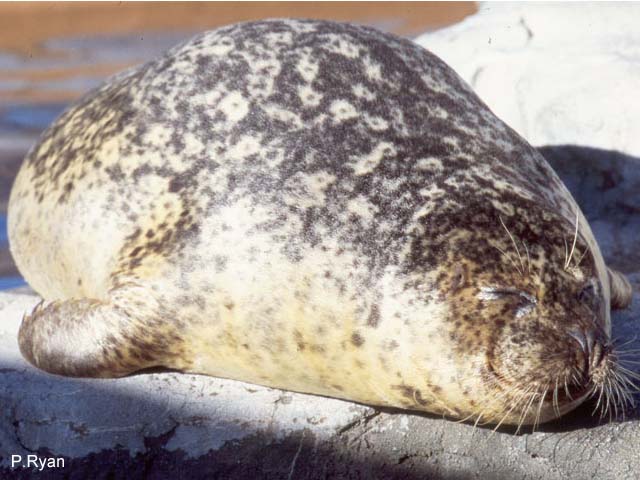
|
Phoca vitulina Linnaeus, 1758 Harbour seal |
||
| Harbor seal | ||

|
|
photo by
Ryan, Paddy |
| Family: | Phocidae () | |||
| Max. size: | 190 cm TL (male/unsexed); 170 cm TL (female); max.weight: 150 kg; max.weight: 110 kg | |||
| Environment: | bathydemersal; marine | |||
| Distribution: | Atlantic Ocean, Pacific Ocean, the Arctic and North America Inland Waters: Portugal, Iceland, Greenland, Canada Newfoundland, Spain, France, Belgium, Ireland, Netherlands, Germany, Denmark, Norway, Sweden Lithuania, Poland, Latvia, Estonia, Finland, Russia, UK, USA, Canada, Mexico, Alaska, Japan, Kamchatka (Ref. 1394), Br Scotland, Madeira, British Columbia, Kuril Island, Sea of Okhotsk, Gulf of California, Baltic Sea, Barents Sea, Hudson Bay (Ref. 1522); Phoca vitulina vitulina: Portugal, UK, Iceland, Greenland, Br Scotland, Norway, Madeira, Baltic Sea, Barents Sea; Phoca vitulina concolor: Canada, Hudson Bay, USA, Greenland, Iceland; Phoca vitulina richardii: Mexico, Alaska, British Columbia, USA, Gulf of California; Phoca vitulina stejnegeri: Japan, Kamchatka, Alaska, Sea of Okhotsk, Kuril Island; Phoca vitulina mellonae: Hudson Bay, James Bay. Temperate to polar regions. | |||
| Diagnosis: | ||||
| Biology: | Found in coastal waters of the continental shelf and slope (Ref. 1394); and whelp in groups on beaches, sandbars, and rocky reefs (Ref. 1522). Feeds on a wide variety of fish, cephalopods, and crustaceans of surface, mid-water and benthic habitats (Ref. 1394). It is preyed upon by the great white shark (Ref. 32140). | |||
| IUCN Red List Status: | (LC); Date assessed: 04 January 2016 Ref. 123251) | |||
| Threat to humans: | ||||
| Country info: | Reported as Phoca vitulina stejnegeri in the western Aleutian Islands and as Phoca vitulina richardii in the eastern Aleutian Islands, the Pribilof Islands, Kuskokwim Bay, and year round in Ilimna Lake (Ref. 1522, 3732). C: Refs. 1522, 1394, 3732, M: Ref. 1394. | |||